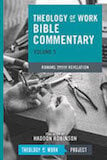Called to Love: Seeing With New Eyes (2 Corinthians 5 Sermon Notes)
Sermon Notes / Produced by The High Calling
2 Corinthians 5:14-19
For the love of Christ urges us on, because we are convinced that one has died for all; therefore all have died. And he died for all, so that those who live might live no longer for themselves, but for him who died and was raised for them.
From now on, therefore, we regard no one from a human point of view; even though we once knew Christ from a human point of view, we know him no longer in that way. So if anyone is in Christ, there is a new creation: everything old has passed away; see, everything has become new! All this is from God, who reconciled us to himself through Christ, and has given us the ministry of reconciliation; that is, in Christ God was reconciling the world to himself, not counting their trespasses against them, and entrusting the message of reconciliation to us.
Theological Point: The love of God in Jesus Christ calls us to love others as God loves them. This means we need to view others based not on outward appearances or circumstances, but as people who are loved by God and have value in God’s eyes. We need to see people from God’s point of view.
Introduction: A sermon is born. Recently during devotions in our pastoral staff at church, we read and discussed this passage from Paul in 2 Corinthians 5:14-19. The passage is well-known and powerful on the subject of reconciliation. But that day our discussion focused on the opening words of v. 16, “From now on, therefore, we regard no one from a human point of view” (NRSV). Someone in the group posed the question, What does it mean to “regard” someone “from a human point of view”?
Danielle, one of our youth ministers, immediately responded, “I think we put people into boxes. We tend to label them from what’s on the outside, when there’s much more to them than what we can see.” Brian, another member of our youth staff, said, “This is where our kids live—in a world that shapes their identities and judges them by outward appearances: by the clothes they wear, the bodies they have or don’t have, by the cars they drive, sports they play, grades they make, and the things they achieve.” Then Brian paused a moment and added, “We could have this discussion every week in youth group and never exhaust it.”
As I thought about that conversation later, a sermon idea was born. Looking at the passage again, I realized how important v. 16 is for understanding the surrounding verses 14 through 19. Why not preach a sermon on 2 Corinthians 5:14-19 focusing on verse 16 and the phrase, “From now on, therefore, we regard no one from a human point of view . . .”?
A. Sorting, Boxing, Labeling. I thought about beginning the sermon by telling the story of our staff conversation. The comments by our youth staff were so poignant. We do live in a culture where we label or judge others by outward appearances and achievement. But that approach seemed too direct. It would place the whole point of the sermon in front of the listener within the first paragraph or two. I wanted a more inductive approach. So I began looking for a metaphor from everyday life that would lead toward the biblical text and the point of the sermon.
I found such a metaphor for the sermon right in my home. My wife Debra is a “beader” who makes beautiful beaded jewelry. It’s intricate, creative, artistic work. To do this kind of work, one has to have an extensive collection of beads on hand. In creating new pieces of jewelry, you never know what kinds of beads you will need. So Debra has thousands of beads of all shapes, sizes, and colors. They’re made of crystals, stones, wood, pearls, shells. They range in size from tiny little “seed beads” to large stones. The varieties are endless. She has her beads carefully sorted, boxed, labeled, and stored in clear plastic containers according to type, size, and color. Hundreds of clear plastic containers!
One day while I was watching Debra organize her beads, I began thinking about how much sorting, labeling, and organizing we do in life. We organize our books, our tools, our dishes. We name and save files and folders on our computers. We organize our world on Blackberries, iPhones, and iPods. I had the metaphor with which to begin this sermon! Everyone can identify with the human need and propensity to box, sort, label, and organize all kinds of things in life. So I began by telling the story of watching Debra sort, label and box her beads.
B. Seeing from a Human Point of View. After the introduction I was ready to apply the sorting and labeling metaphor to how we view and treat people. So I said something like: “All this sorting and labeling might be good for beads and books, pots and pans, or computer files. But it’s not good to do with the people in our lives. We live in a culture where we judge each other by outward appearances and first impressions. We look at the outside of people rather than the inside. We sort, label, and box people into categories of race, gender, class, politics, religious beliefs, age, physical and mental abilities. We segregate. We build walls between people groups. We create boundaries of division that lead to misunderstanding, prejudice, and injustice. We label people and keep them at a distance.”
You don’t have to look far to find examples of this. In our consumer and celebrity culture the obsession with outward appearances is everywhere. Think of stories or examples of this from your own experience to illustrate a sermon on this text. I’m reminded of how difficult it was for our two daughters growing up as adolescents. Many of their struggles were about outward appearance, self-image, and self-esteem. My wife once wrote an essay on our culture’s “love affair with Barbie.” Debra said, “Barbie represents every insecurity I’ve had learning to live in my own skin. She’s everything I’m not: perfect hair, perfect face, perfect body, perfect life—an unattainable ideal.”
Of course, tragic examples of stereotyping, prejudice, and hatred also abound in our world. They have led to segregation, oppression, violence, wars, and genocide—much of it originating from the human propensity to judge and condemn others on the basis of outward appearances and differences.
After talking about the problem of judging others by human ways of thinking, I was ready to introduce the text from 2 Corinthians. I decided to do that by telling the story of our staff discussion which I related above at the beginning of these outline notes. That conversation gave me the idea for the sermon, but rather than opening the sermon with it, I chose to hold it as a transitional illustration introducing the biblical text. So I told the story of our staff discussion of the question: What does it mean to ‘regard someone from a human point of view’?” The comments by Danielle and Brian on “boxing” and “labeling” were a narrative way of introducing both the text and the problem the sermon addressed—our tendency to regard, evaluate, or judge people by external or human standards.
Once verse 16 of the text is introduced, you may want to interpret its wording in more detail. Careful study of the words and phrases in the verse can helpfully inform the sermon at this point. For example, why does Paul say, “From now on, therefore, . . .”? The word “therefore” is important. It points to a conclusion Paul is drawing based on what he has been saying in the previous section of the letter (4:7-5:15). Exegetical study of the context here helps us interpret more accurately the point Paul is making.
Also, how are we to understand the Greek word oidamen? It literally means “we know,” but its nuance here may be rendered “regard” (NRSV, NIV), “judge” (TEV), “estimate” (NEB), “esteem,” or “value.” Finally, the phrase “from a human point of view” (NRSV). The Greek reads kata sarka, “according to the flesh.” A check of various versions or paraphrases is interesting: “from a worldly point of view” (NIV); “by human standards” (TEV); “worldly standards” (NEB); “by what is external” (Moffatt); “by what they have or how they look” (Message).
C. Seeing with New Eyes. Having introduced the biblical text, the sermon can now move on to the question: If we no longer regard others from a human point of view, how then should we regard them? The context of 2 Corinthians 5:16 shows that two things are at work here:
1. Just before our text, in v. 12, Paul refers to “those who boast in outward appearance and not in the heart.” Paul is referring to his opponents in Corinth who had asserted physical criteria for assessing the legitimacy of his apostleship. They apparently had charged that Paul didn’t have the appearance, skills, status, or religious experience of a true apostle. Paul defends his apostolic call and ministry by arguing that his critics were judging others from a human point of view. They were also boasting of their own religious experiences, status, and power.
2. Rather than judging outward appearances, Paul appeals to Christ’s love for us expressed in his death and resurrection (vv. 14-15) as the only appropriate basis for “seeing” or “regarding” others (v. 16). Because of Christ’s love for us, demonstrated in his death on the cross and in the resurrection, we don’t view other people the same way anymore. We look to the heart rather than to the face, or to outward achievements or experiences. We see others with new eyes. We view other people from God’s point of view. “If anyone is in Christ, there is a new creation,” Paul says, for Christ has made all things new (v. 17). He is talking about a new way of seeing others.
What does it mean to “see with new eyes”—to view other people from God’s point of view? The key in this text is what Paul says in v. 16b: “Even though we once knew Christ from a human point of view, we no longer know him in that way.” Paul is speaking of his own personal story. He says, “I once knew Christ from merely a human point of view.” Earlier in Paul’s life, by all outward appearances, Jesus was to Paul just another Jewish messianic pretender—one of many who had come on the scene. A human imposter, he was crucified by the Romans. But now, Paul says, “I no longer view him or know him in that way.”
Something dramatic had happened in Paul’s life. On the road to Damascus, he met the resurrected and living Christ, and that experience radically changed Paul. He saw everything with new eyes, felt everything with a new heart. His old life passed away; everything became new. He was given new eyes, a new way of seeing Christ. Paul became a committed follower and apostle of Jesus the Messiah, the crucified and risen Lord. Because of that life-changing experience, Paul was convinced that “Christ died for all” (v. 15). And because Christ died for all people—all people have value in God’s eyes. All people are loved by God. And the love of God in Jesus Christ compels us to live for Christ and to love others as God loves them (vv. 15-16).
Paul goes on to say in v. 17, “So if anyone is in Christ, there is a new creation: everything old has passed away; everything has become new!” When we accept the gift of what God has done in Christ, everything changes. We become part of “a new creation”—God’s new eschatological age of salvation. In Christ we are given new eyes, a new way of seeing. No longer do we sort and label people and put them into boxes of our own prejudice and self-interest. No longer do we judge them based on their outward appearance or circumstances. Rather, we look to what is not seen, to the inner person, to the heart. We see people from God’s point of view.
Conclusion: Reconciling love. Having talked about the contrast between seeing others from a human point of view and seeing them from God’s point of view, I concluded the sermon by talking about how this new way of seeing transforms our relationships. When we see with new eyes, we look at our families and friends differently. We see our daily work differently. We view our church differently. We see the world around us differently. We view people of other cultures, races, and classes through the eyes of God. We open our hearts and reach out to them in love. We finds ways to reconcile our differences with other people.
This new way of seeing is not something we do ourselves. It is a gift of God’s transforming grace. Paul concludes in v. 18, “All this is from God, who reconciled us to himself through Christ, and has given us the ministry of reconciliation….” In Christ’s death and resurrection we are reconciled to God and at peace with God. In Christ, therefore, “we no longer regard anyone one from a human point of view. We see others from God’s point of view.”
In the conclusion to the sermon, I also spoke briefly of how our ministry of reconciliation (v. 18) flows out of learning to see others differently. God sends us into the world to be people of healing and reconciliation. All around us there are people who need our reconciling love. They are people who are very different from us. They are also people right next door to us—people in our families, at work, in our church. The question is: Whom do you and I need to view with new eyes? Will we tear off the labels and open the boxes we have put people in? Will we free them from our own fears and prejudices? Will we reach out to them in love? The love of Christ calls us to live no longer for ourselves, but for him who died and was raised for us all. From now on, therefore, we regard no one from a human point of view.
Connection to Daily Life and Work: When we see others as God sees them, we no longer “regard them from a human point of view.” This new way of seeing transforms our relationships. We look at our family, friends, coworkers, and people of other races and cultures differently. We reach out to them in love.
********************************************************************
These sermons are by The Rev. Dr. Gary Klingsporn, Senior Minister of First Congregational Church in Nantucket, Massachusetts. Before moving to Nantucket in January 2010, he previously served for twenty years as Teaching Minister and Minister of Spiritual Formation at Colonial Church in Edina, Minnesota. He has contributed many articles to www.TheHighCalling.org and has served as a seminary instructor and writer or editor on a number of publishing projects. He received a Ph.D. in Religious Studies from Baylor University (1985).
Click here for a PDF of this sermon.
Other sermons in this series on Called to Love:











